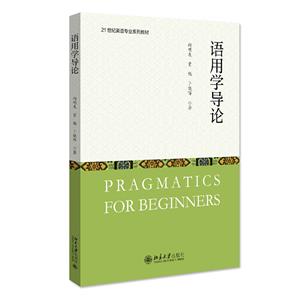-
>
新东方 背单词,记住这200个词根词缀就够了
-
>
(精)古代汉语三百题
-
>
增广贤文
-
>
优秀的绵羊
-
>
北京大学
-
>
新视野大学英语(第三版)读写教程.2
-
>
初中数学应用题解规律
语用学导论 版权信息
- ISBN:9787301329351
- 条形码:9787301329351 ; 978-7-301-32935-1
- 装帧:一般轻型纸
- 册数:暂无
- 重量:暂无
- 所属分类:>
语用学导论 本书特色
本书假简洁英文,借生动实例,阐释艰深语用学议题,以期满足初学者学习需求,培养其人文悟性,提升其言语交际能力。全书由引言、指称语、预设、会话含义、言语行为、(不)礼貌、研究方法等七章正文和两个附录组成。每章包含核心概念导入、经典及前沿理论概述、理论嬗变阐释、个案剖析及章节要点回顾等要件。本书缘起本科生考试改革,从学生期末课程作业起步,由教授与两位优秀本科生合作完成,堪称以考促学、科教融合的成功案例。
语用学导论 内容简介
本书定位读者为语用学初学者,因此从学生视角出发,力图生动简洁,在阐述语用学研究经典议题的同时,引入对经典理论的批判及近期科研成果,引发读者思考,帮助初学者掌握相关概念,培养其独立研究思考的能力。全书主体由七章正文及两节附录组成。**章为引言;二到六章阐述指称语、预设、会话含义、言语行为、礼貌及不礼貌等五大语用学核心议题;第七章简述语用学研究中常见的文献梳理、数据收集及分析方法;两节附录为初学者提供实用学习资源。组织架构上,每章由正文及要点回顾组成。其中二到六章正文分别论述议题中的经典理论、发展前沿,并辅以个案研究。
语用学导论 目录
Chapter 1Introduction
1.1Definitions of pragmatics
1.2Meaning and context
1.3Development of pragmatics
1.4Organization of the book
1.5Review
Chapter 2Deixis
2.1Preliminaries
2.2Deictic and nondeictic uses
2.3Types of deixis
2.3.1Person deixis
2.3.2Time deixis
2.3.3Place deixis
2.3.4Social deixis
2.3.5Discourse deixis
2.4Applications: Chinese vocatives as pragmatic markers
2.4.1Introduction
2.4.2Vocatives and coherence
2.4.3Vocatives and involvement
2.4.4Vocatives and (im)politeness
2.5Review
Chapter 3Presupposition
3.1Entailment
3.1.1Preliminaries
3.1.2Types of entailment
3.2Presupposition
3.2.1Preliminaries
3.2.2Types of presupposition
3.2.3Properties of presupposition
3.2.4Presupposition trigger
3.3A comparison between entailment and presupposition
3.4Applications: Entailment and presupposition in real life
3.4.1English writing
3.4.2Interpersonal communication
3.5Review
Chapter 4Implicature
4.1Preliminaries
4.1.1Natural and non-natural meaning
4.1.2Implicature and implication
4.2Types of implicature
4.2.1Conversational and conventional implicatures
4.2.2Generalized and particularized conversational implicatures
4.2.3Scalar, alternate, and clausal implicatures
4.3Classical Gricean Theory
4.3.1Cooperative principle
4.3.2Creation of conversational implicature
4.3.3Criticisms of Gricean theory
4.4NeoGricean and PostGricean Theories
4.4.1Levinson’s Q, I, and MPrinciples
4.4.2Horn’s Q and RPrinciples
4.4.3Sperber & Wilson’s Principle of Relevance
4.4.4Retrospections
4.5Properties of conversational implicature
4.6Applications: Exploiting the four Maxims in Friends
4.6.1Exploiting the Maxim of Quantity
4.6.2Exploiting the Maxim of Quality
4.6.3Exploiting the Maxim of Relation
4.6.4Exploiting the Maxim of Manner
4.7Review
Chapter 5Speech Acts
5.1Preliminaries
5.1.1Performativeconstative dichotomy
5.1.2The performative hypothesis
5.2Austin’s theorizing of speech acts
5.2.1Felicity conditions on performatives
5.2.2Locutionary, illocutionary, and perlocutionary acts
5.2.3Types of illocutionary force
5.3Searle’s theorizing of speech acts
5.3.1Felicity conditions on speech acts
5.3.2Typology of speech acts
5.3.3Direct and indirect speech acts
5.4Recent developments in Speech Act Theory
5.4.1Study of perlocution
5.4.2Classifications of speech acts
5.4.3Sequencing in speech acts
5.5Speech acts across cultures and contexts
5.5.1Crosscultural variations
5.5.2Intralanguage variations
5.6Applications: Persuasion in Chinese online forum requests
5.6.1Introduction
5.6.2Ethos: Projecting self to the requestees
5.6.3Pathos: Awakening the emotion of the requestees
5.6.4Logos: Reasoning with the requestees
5.7Review
Chapter 6Politeness and Impoliteness
6.1Theorizing politeness
6.1.1Characterizing politeness
6.1.2Politeness as strategic face management
6.1.3Politeness as a conversational maxim
6.1.4Politeness as situated evaluation
6.2Theorizing impoliteness
6.2.1Types of impoliteness
6.2.2Impoliteness as strategic face attacks
6.2.3Impoliteness as conversational maxims
6.2.4Impoliteness as a discursive practice
6.3Some potential issues in (im)politeness research
6.4Applications: Politeness in online forum requests
6.4.1Introduction
6.4.2Bald on record strategies
6.4.3Positive politeness strategies
6.4.4Negative politeness strategies
6.5Review
Chapter 7Research Methods
7.1Literature mining
7.1.1Four types of exigences
7.1.2Review articles and bibliographies
7.1.3Search engines and databases
7.1.4Bibliometric analysis and knowledge visualization
7.2Data collection
7.2.1Interviews
7.2.2Questionnaires
7.2.3Discourse completion tests
7.2.4Role plays
7.2.5Recordings
7.2.6Trending methods
7.3Analytical methods
7.3.1Conversation analysis and discourse analysis
7.3.2Statistical analysis
7.4Review
References
Appendix One Resources
Appendix Two Research Notes
语用学导论 作者简介
向明友,对外经济贸易大学教授、博士生导师,教育部新世纪优秀人才,兼任国家社科基金、教育部人文社科基金评审专家,国家留学基金委评审专家,中国语言教育研究会副会长,中国外语教学研究会ESP专业委员会常务理事,中国语用学研究会理事。
- >
苦雨斋序跋文-周作人自编集
苦雨斋序跋文-周作人自编集
¥5.8¥16.0 - >
烟与镜
烟与镜
¥24.0¥48.0 - >
名家带你读鲁迅:朝花夕拾
名家带你读鲁迅:朝花夕拾
¥10.5¥21.0 - >
二体千字文
二体千字文
¥22.4¥40.0 - >
龙榆生:词曲概论/大家小书
龙榆生:词曲概论/大家小书
¥13.0¥24.0 - >
大红狗在马戏团-大红狗克里弗-助人
大红狗在马戏团-大红狗克里弗-助人
¥3.5¥10.0 - >
莉莉和章鱼
莉莉和章鱼
¥13.4¥42.0 - >
月亮与六便士
月亮与六便士
¥15.1¥42.0
-
新时代大学英语 读写译教师用书2
¥29.3¥39 -
新东方 背单词,记住这200个词根词缀就够了
¥8.3¥15 -
实用英语简捷语法
¥47.8¥78 -
新编英汉翻译教程
¥39.5¥55 -
新视野大学英语(读写教程4思政智慧版第3版十二五普通高等教育本科国家级规划教材)
¥35.3¥69.9 -
4.23文创礼盒A款--“作家言我精神状态”
¥42.3¥206





















